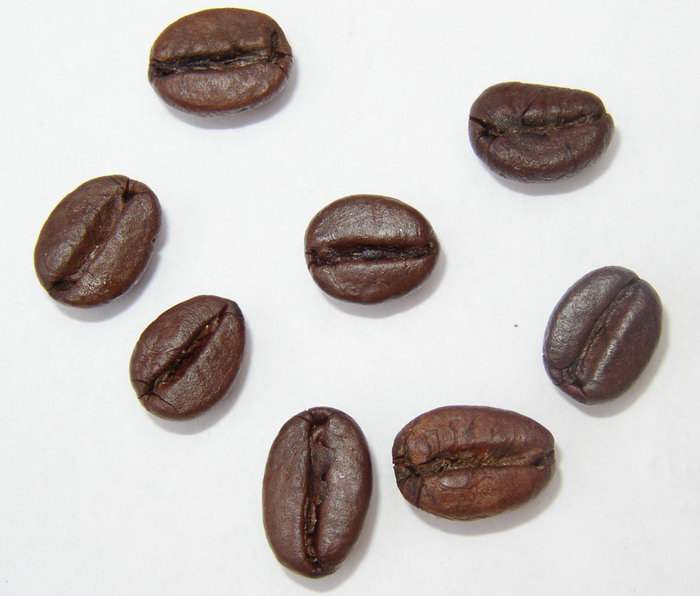Coffee in the Galapagos
Follow the caf é (Wechat official account vdailycom) and found that Beautiful Cafe opened a small shop of its own.
Ecuador is a country located in South America. Coffee beans are divided into two varieties: Galapagos and Gigante, both of which have the characteristics of large grains and heavy weight. Galapagos (Galapagos) is pronounced in Spanish and we translate it into Cologne in Chinese. It belongs to Ecuador nationally, but its coffee will not be named Ecuador, because although Galapagos belongs to Ecuador, it is located in the Pacific Ocean, more than 1100 kilometers away from the mainland and covering an area of more than 7500 square kilometers. it is an archipelago of 13 islands and 19 reefs solidified by undersea volcanic eruptions, stretching 1000 kilometers from the South American continent to the Pacific Ocean.
Coffee in the Galapagos Islands has its own uniqueness. It was brought to the island around 1870. 150 years later, coffee varieties are still the original species of coffee grown at that time-the ancient bourbon species. It has never been bred by any artificial cross. And the coffee on the island is basically grown in the mountains about 500m above sea level. Friends who have seen our coffee bean series should know that the higher the altitude, the better the quality of coffee. Generally speaking, it is necessary to reach an altitude of 1700 to 2100 meters before it can be called high-quality coffee beans. Isn't this 500m a long way off?

This is what makes Galapagos Coffee unique, because the archipelago is located at the confluence of cold currents in Peru in the south and warm equatorial currents in the north. Affected by the cold and warm ocean currents, a small ecological environment has been formed. The climate of 500m here is equivalent to that of 900m-1800 m inland. This terrain is very suitable for the growth of very hard coffee beans (SHB) with high acidity, and is also the key to the high quality of coffee.
Coffee producing areas of the Galapagos Islands:
Coffee is grown in San Cristobal (SaintCristobal). Arab bourbon coffee trees are planted in the Hasunda Coffee Garden (HaciendaElCafetal) in San Cristobal. The elevation of the plantation is between 140 and 275m, and the climate of the area is equivalent to that of 915m to 1830 m inland. This gradient is suitable for the growth of high acidity extra hard coffee beans (SHB) and is the key to the high quality of coffee.
St. Cristobal is a larger island in the Galapagos Islands (Galapagos Islands) and the only one in the archipelago with plenty of fresh water. At an altitude of 410m, there is a small lake called El.Junco, which forms streams along the rocks and volcanic rocks on the southern slope of the island, and mineral-rich fresh water moistens the land of St. Cristobal, keeping the soil moist and fertile. The local microclimate caused by the Humboldt current (HumboldtCurrent), strong equatorial sunlight and sharp temperature changes (43 degrees at sea level and 10-16 degrees above sea level at 275m) provide unique advantages.
The quality of Galapagos coffee is very good, and it is mainly exported to Scandinavia and other Nordic countries, so our people know little about it. As coffee is consumed by people all over the world, the world coffee industry is also developing towards a mass production model. A small-scale planting model like Galapagos actually limits its development, and if it does not expand its scale, it may eventually be forced to give up because of unprofitable profits. Coffee plantation owners here are also aware of this problem and gradually expand the area of their estates in the early 1990s to make full use of their unique advantages.
The Galapagos archipelago is now designated as a national park by Ecuador and listed as "human property" by UNESCO. It is far from land and largely avoids the impact of human behavior on nature. In order to maintain the local natural ecology as much as possible, Ecuador legally prohibits the use of all kinds of artificial fertilizers, herbicides and pesticides. Therefore, the Galapagos coffee beans are all organic coffee beans, which are grown without any chemical agents and are recognized as natural green boutique coffee. this naturally grown coffee is mild and rich in taste, sweet in sour and slightly floral, fruity and caramel.
In fact, most island beans are very likeable, but low production and high prices also widen the gap between them and the public. Recently, this Galapagos appeared in our students' coffee tasting list. After medium roasting, it shows a good sense of balance, soft acidity, refreshing flower fragrance, like jasmine and early autumn sweet-scented osmanthus, which is really a bit of blue mountain style! If you like the Blue Mountain style and consider the value for money, choose this Galapagos.
When looking for information, I was deeply attracted by the beautiful scenery of the Galapagos Islands. Scientists have verified that there are more than 700 kinds of ground animals, more than 80 species of birds and many insects living on the island. Darwin visited the island. I got the insight from it and created the Theory of Evolution. On this island called the living Museum of Biological Evolution and showroom, we can see very unusual animal species such as terrestrial iguanas and giant turtles, and our coffee is really much younger than these rare species! But they are like different colors, and the Galapagos Islands is a palette that brings together many colors to form a colorful picture that is presented to the world.
Important Notice :
前街咖啡 FrontStreet Coffee has moved to new addredd:
FrontStreet Coffee Address: 315,Donghua East Road,GuangZhou
Tel:020 38364473
- Prev

Introduction to 90 + Coffee Candle Flavor, taste and aroma
Following Cafe Review (official Wechat account vdailycom) found that Beautiful Cafe opened a small shop of its own. The charming fruit tone inherits the charming aroma given by the traditional Egyptian sun, unreservedly expressing round, full, long aftertaste sweetness and just right fruit acidity. The daily brewing of candlelight is also quite easy to use, and the bean itself is rich in flavor, whether it is clear.
- Next

Bolivian coffee hand-made reference and flavor description
Following caf é (Wechat official account vdailycom) found that Beautiful Caf é opened a small shop rich in coffee beans in South America, and Bolivia is no exception. The unique rainforest environment in some parts of Bolivia provides excellent natural conditions for the growth of organic coffee. The aroma of Bolivian coffee is rich and unique, whether it is the aroma of ground beans or made.
Related
- Detailed explanation of Jadeite planting Land in Panamanian Jadeite Manor introduction to the grading system of Jadeite competitive bidding, Red bid, Green bid and Rose Summer
- Story of Coffee planting in Brenka region of Costa Rica Stonehenge Manor anaerobic heavy honey treatment of flavor mouth
- What's on the barrel of Blue Mountain Coffee beans?
- Can American coffee also pull flowers? How to use hot American style to pull out a good-looking pattern?
- Can you make a cold extract with coffee beans? What is the right proportion for cold-extracted coffee formula?
- Indonesian PWN Gold Mandrine Coffee Origin Features Flavor How to Chong? Mandolin coffee is American.
- A brief introduction to the flavor characteristics of Brazilian yellow bourbon coffee beans
- What is the effect of different water quality on the flavor of cold-extracted coffee? What kind of water is best for brewing coffee?
- Why do you think of Rose Summer whenever you mention Panamanian coffee?
- Introduction to the characteristics of authentic blue mountain coffee bean producing areas? What is the CIB Coffee Authority in Jamaica?

